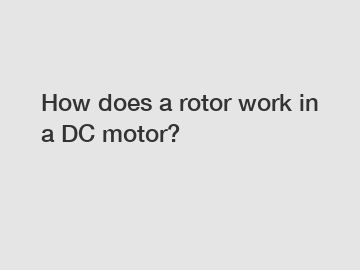How does a rotor work in a DC motor?
If you are looking for more details, kindly visit CHME.
How does a rotor work in a DC motor?
The rotor is a crucial component in a DC motor as it is responsible for converting electrical energy into mechanical energy. Understanding how the rotor works is essential for comprehending the functioning of a DC motor. In this article, we will explore the intricacies of the rotor and its role in a DC motor.

1. Definition and Construction of the Rotor.
The rotor, also known as the armature, is the rotating part of a DC motor. It is typically composed of a cylindrical core made of laminated iron, divided into several slots to accommodate the winding. The winding consists of insulated copper wire coils, known as armature coils, which are connected to the commutator. The commutator is a segmented cylindrical structure that serves to control the direction of the electric current in the rotor.
2. Electromagnetic Principles.
The rotor operates based on the principles of electromagnetic induction. When electric current is passed through the armature coils, a magnetic field is produced. This magnetic field interacts with the stationary magnetic field generated by the stator (the fixed part of the motor), resulting in a force that induces rotation in the rotor.
3. Role of the Commutator.
The commutator plays a vital role in the operation of the rotor. As the rotor rotates, the commutator ensures that the direction of current in the armature coils changes at precise moments. This reversal of current direction allows the rotor to continue its rotation in a specific direction. The commutator achieves this by maintaining electrical contact with the stationary brushes, which are connected to an external power source.
4. Brush and Brushless DC Motors.
In traditional DC motors, the brushes and commutator are essential components for the operation of the rotor. However, brushless DC motors have gained popularity due to their improved efficiency and reduced maintenance requirements. In brushless DC motors, the rotor contains permanent magnets, eliminating the need for brushes and commutators. Instead, the stator's magnetic field is electronically controlled to generate the desired rotation in the rotor.
5. Magnetic Field Interactions.
The magnetic field interactions between the rotor and the stator are crucial for the motor's efficient operation. The strength and alignment of the magnetic fields influence the torque, speed, and overall performance of the motor. Adjusting the magnetic field intensity or introducing additional windings can enhance the motor's efficiency and power output.
6. Controlling Speed and Torque.
By varying the voltage supplied to the rotor, the speed and torque of the motor can be controlled. Increasing the voltage increases the speed of the motor, while increasing the current increases the torque. These parameters can be finely tuned to suit the specific requirements of various applications.
7. Applications of DC Motors.
DC motors find extensive use in various applications, ranging from small household appliances to industrial machinery. They are commonly employed in electric vehicles, robotics, power tools, and many other devices where precise control of speed and torque is necessary.
To summarize, the rotor in a DC motor plays a crucial role in converting electrical energy into mechanical energy. Through electromagnetic induction and the interaction of magnetic fields, the rotor spins, generating rotation and enabling the motor to perform mechanical work. The commutator and brushes or the use of permanent magnets (in brushless DC motors) are essential components for the proper functioning of the rotor. Understanding these principles helps us appreciate the versatility and wide-ranging applications of DC motors in today's technological world.
Please visit our website for more information on this topic.
If you are looking for more details, kindly visit custom stamped stator cores and lamination.



